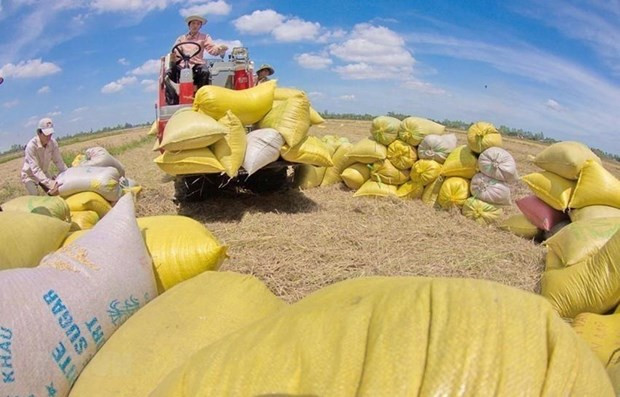 Farmers harvest rice in Vi Binh commune of Vi Thuy district, the Mekong Delta province of Hau Giang (Photo: VNA)
Farmers harvest rice in Vi Binh commune of Vi Thuy district, the Mekong Delta province of Hau Giang (Photo: VNA)Sydney (VNA) - SunRice CEO RobGordon, head of Australia’s largest rice supplier, has announced that Australiais suffering a massive shortage of domesticrice supplies and would be forced to rely on imported Vietnamese rice in thelead up to Christmas 2020.
In an article posted on thewebsite australiavietnam.org, James Fairley of the Australia – Vietnam YoungLeadership Dialogue wrote that these announcements emphasise nuances (and fear) of the growingeconomic fallout of COVID-19, compounded by the impacts of climate change onAustralian domestic production. Perhaps more broadly however, such a shortagerepresents yet another opportunity for Australia in the face of growing callsfor trade diversification and integration with new markets.
Australia’s rice market
Accordingto the article, Australia’s rice production remains highly variable due to changing water availability and prices ofalternative crops, amounting to merely 0.4 percent of total anticultural productionvalue between 2017-2018. According to the Australian Bureau of Agricultural andResource Economics and Sciences (ABARES) and the Australian Bureau ofStatistics (ABS)2019-2020 crop yielded about 57,000 tonnes of rice and is, weather permitting,forecast to reach 266,000 tonnes in 2020-2021. This remains well below the 10-year average to2018-2019 of 629,000 tonnes.
In any event, ABARES predicts that“fundamental changes in demand for water and relatively low returns for riceproduction mean that Australia is likely to grow less rice” and turn crops likecotton which have benefited from technological developments and benefited mostfrom the US-China trade dispute.
Founder and Managing Directorof agribusiness firm Lefarm Co. Ltd and AVYLD alumni Nguyen Le agrees, statingthat “It is a natural movementtowards importing more instead of producing more...the real question is, willAustralia focus on importing out of necessity, or on forming sustainablelong-term strategy to share and co-develop innovations with Vietnam to betteralign demand and supply when time comes?”
Australians consume about 300,000 tonnes ofrice annually, with imports accounting for about half of all consumption – an average of 173,000 tones between 2009-2010 and 2018-2019.Most rice imports are from long grain rice producing countries like Vietnam,Thailand, Pakistan and India, with import’s providing more stable production asopposed to Australian variable domestic production levels.
Australian domestic productionvariability of rice, particularly in the 2019-2020 crop yield, highlights theincreasing demand for alleviation of shortages by imports. As ABARES suggests,in the short term (and given the 2019-2020 yield deficit as above), sincedomestically produced rice is harvested in autumn - once per year - no newdomestic supply will be available in Australia until 2021. Any shortages canonly be alleviated via imports.
Vietnam’s rice exports
Vietnam is a key producer and exporter of riceglobally and has significantly increased productionand exports year on-year, meeting increasing global demand. According toBusiness Monitor International (BMI), Vietnamese rice exports rose by30 percent year-on-year in the 2016-2017 harvest due to strong demand by China,the Philippines and Indonesia.
Exports are forecast to continue to rise from6.1 million tonnes in 2020 to more than 7.86 million tonnes by 2023-2024. Thismay be driven by Vietnam’s price competitiveness against regional neighbourslike Thailand, underscored by Vietnamese government intentions to increasehybrid rice variety production by 50 percent, bolstering future production andexport capabilities.
Unlikeits neighbours and competitors like Thailand,Vietnam enjoys elevated rice yields as a result of the governments past cropintensification policy, which encouragedfarmers to skip crop rotation to maximise production annually.
Nevertheless, Vietnam remains challenged bythe increasing water levels in the Mekong Delta, driven by climate change andits impact on soil conditions. These are compounded by issues with sorting andgrading, and storage of rice.
Bipartisan calls for trade diversification
Australia’s rice deficit and the growingviability of enhanced trade in rice with Vietnam are strengthened by growingsocio-political sentiment about strategic reliance and trade imbalances broughtabout by the economic consequences of COVID-19.
The impact of a halt to globalisation andeconomic interconnection (whether through border closures, localised shutdownsof manufacturing and exporting or otherwise) has accelerated calls for arethink about who, why and what Australia partners with, in trade andinnovation.
There are calls for Australia to look beyondits traditional partners in China, Japan, the United States and the Republic ofKorea (who together account for 55.5 percent of Australian trade) and towards“growing regions that complement Australian goods, services and expertise,which offer significant potential to diversify”.
Opportunities with Vietnam
Indeed, Australia can expandits relations with Vietnam by driving meaningful mutually beneficialimprovements in this industry. Canberra can drive new partnerships ininnovation, leveraging institutional knowledge in the Commonwealth Scientificand Industrial Research Organisation (CSIRO), ABARES and others to aide Vietnameserice export quality and growth to Australia. These Departments can concurrentlystrengthen existing policy agendas in rice by other Departments like theAustralian Centre for International Agricultural Research (ACIAR).
Concurrently, Canberra cansupport Australian farmers to transition to crops benefiting most fromtechnology like cotton – a sector which has benefited greatly from the US-Chinatrade dispute and a fast-growing import for Vietnam.
In the end, Australia shouldnot view imports from Vietnam as a last resort, but an opportunity for theforging of longer term meaningful links with emerging partners for both countries' sake./.





























